The story of Dachau, as told to touristsDachau Museum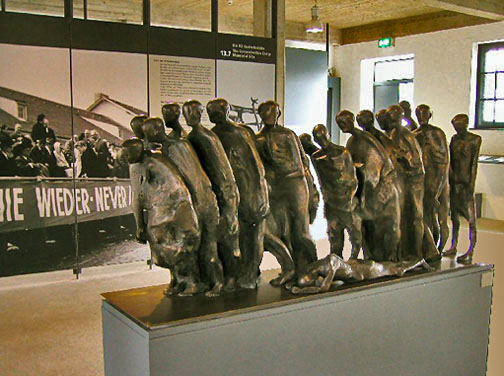 When I visited in May 2007, a new sculpture, shown in the photo above, had been added to the Museum since my previous visit in 2003. A new Visitor's Center with a cafeteria opened on April 30, 2009 and many visitors are critical of the fact that food is available just outside the former concentration camp. For years, it was thought that eating at the Memorial Site would be disrespectful to the dead. When I visited in May 2007, I saw tourists who had brought food with them to the camp and were munching on sandwiches or eating from plastic containers as they toured the site. I had to remove a food wrapper before taking a photo of the gas chamber. The railroad station at Dachau is about two miles from the Memorial Site, but some tourists are critical of the McDonald's restaurant there because it is too close to the hallowed ground of the former camp. Visitors to Dachau first go to the Museum in the former service building. They enter through the west wing which is where the prisoners were processed upon arrival. 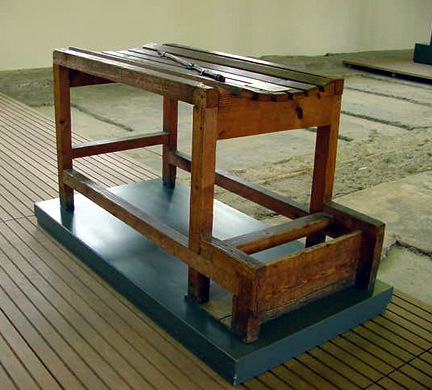 In the Museum, a whipping block, that was used to punish the prisoners, is displayed. Visitors are told that prisoners were given 25 lashes for such minor offenses as having a button missing from their uniform or putting their hands in their pocket. One visitor wrote this on his blog: In the shower room they had set up a table where they used to whip people if they did anything against the rules. The rules included things such as having a dried spot of water on the bowl you ate out of. What visitors are not told is that all punishments had to be authorized by WVHA, the Central Office for Economic Administration in Oranienburg, after a report was filed; punishments for women had to be personally approved by Reichsführer-SS Heinrich Himmler. Imagine someone at the central office in charge of the camps reading a request for punishment of a prisoner who had a "dried spot of water" on his bowl. Visitors are not told that the whipping block was no longer used after 1942 when Reichsführer-SS Heinrich Himmler gave an order that the SS men in the concentration camps were forbidden to "lay violent hands on the prisoners." In the Museum, visitors see the former shower room where prisoners were allegedly hung by their arms as a punishment. The shower room is on the left in the photo below; the water pipes and shower heads have been removed. Notice the patches at the top of the beams where cross bars used to be. The bars had been removed when the hanging punishment was discontinued at Dachau in 1942, but the locations were uncovered when the building was turned into a Museum. 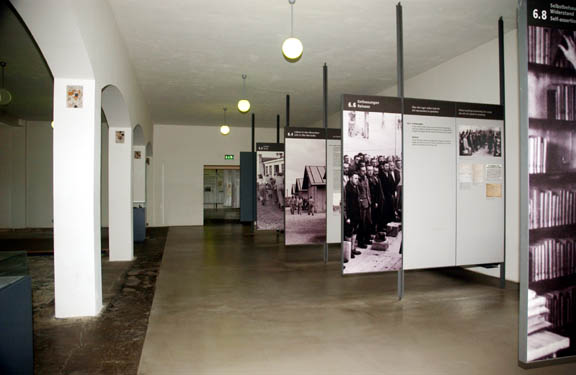 On the right side of the photo below is a bar across one of the arches. Visitors are shown a chain which was allegedly used to hang prisoners from the bar for punishment. 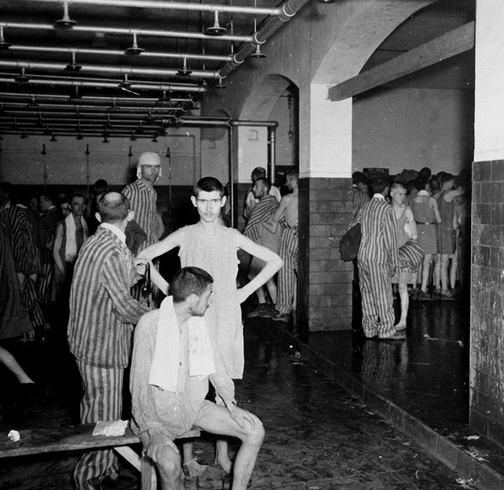 The hanging punishment was originated by Martin Sommer, an SS officer at Buchenwald. This punishment was abolished at Dachau by Commandant Martin Weiss in 1942. Sommer was dismissed from his job at Buchenwald and sent to the Eastern front after being put on trial in SS judge Dr. Georg Konrad Morgen's court in 1943 for abuse of the prisoners. 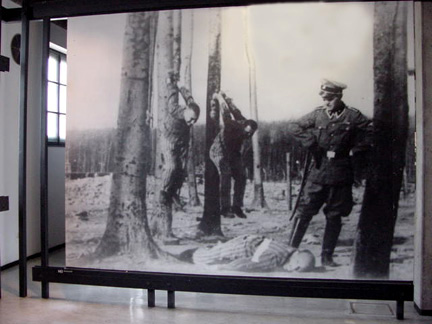 The photograph above, taken inside the old Dachau Museum in May 2001, shows a scene at Buchenwald that was created in 1958 for an East German DEFA film. (Source: H. Obenaus, "Das Foto vom Baumhängen: Ein Bild geht um die Welt," in Stiftung Topographie des Terrors Berlin (ed.), Gedenkstätten-Rundbrief no. 68, Berlin, October 1995, pp. 3-8) This fake photo is not included in the new Dachau Museum which opened in 2003, but all the tour guides at Dachau dwell at length on the hanging punishment. One of the most important events in World War II was the liberation of Dachau, but it was not mentioned at all in the old Dachau Museum. At the end of the Museum exhibits that were put up in 2003, there is a photo of American soldiers shooting SS men who have surrendered. These were Waffen-SS soldiers who had been sent from the battle front to surrender the camp. 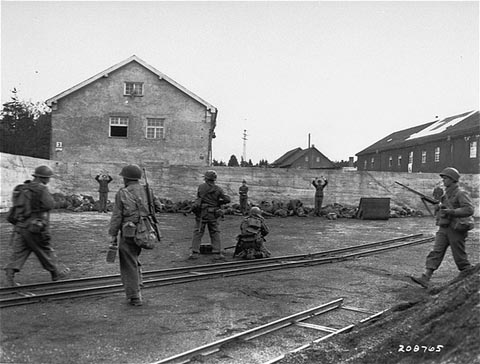 Although the official US Army report stated that there were 31,432 inmates at Dachau when the camp was liberated, a tour guide told visitors in August 2008 that there were 76,000 prisoners there when the camp was liberated. The Dachau Bunker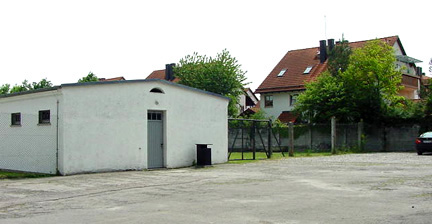 After visiting the Museum at Dachau, visitors then proceed to the bunker (camp prison) which is located behind the museum building. Many visitors are outraged when they see the houses that were built right behind the bunker in the 1990s; they consider Dachau to be sacred ground that must not be desecrated by people living a few feet from where the prisoners were tortured, according to the tour guides. The Dachau tour guides put great emphasis on stories about the prisoners being tortured in the bunker, but the interrogation room, where prisoners were allegedly tortured, was occupied from 1943 to 1945 by British Major Richard H. Stevens, who was arrested at Venlo in Holland on November 9, 1939 on a charge of conspiring to assassinate Hitler and overthrow the German government. This was during the period of time that numerous spies and Resistance fighters were brought to Dachau by the Gestapo and allegedly tortured. Visitors are not told by their guides that SS "war criminals" testified at the proceedings of the American Military Tribunal at Dachau that they were tortured by American interrogators to force them to confess to crimes that they claimed they had not committed. Johann Kick, the head of the Gestapo branch office in the bunker, denied that the prisoners were tortured; on the contrary, he claimed that he himself was tortured into confessing crimes that never happened at Dachau. The following quote is from the testimony of Johann Kick at his trial before an American Military Tribunal held at Dachau in 1945: I was here in Dachau from the 6th to the 15th of May, under arrest; during this time I was beaten all during the day and night... kicked... I had to stand to attention for hours; I had to kneel down on sharp objects or square objects; I had to stand under the lamp for hours and look into the light, at which time I was also beaten and kicked; as a result of this treatment my arm was paralyzed for about 8 to 10 weeks; only beginning with my transfer to Augsburg, this treatment stopped. The SS wing of the bunker has been torn down and visitors are not told that Dachau formerly had one of the two prisons for SS guards who were convicted of mistreating concentration camp inmates. (The other one was the Danzig-Matzkau camp near the city formerly known as Danzig.) Instead of telling visitors that the Dachau guards were imprisoned for killing or abusing the prisoners, the tour guides give information such as the following which is a quote from A visitor's impressions of Dachau: When the Jews became a major part of Dachau, the conditions got even worse. Guards would take target practice using human targets for fun. Men would be thrown into "no-man's land" - a small section between the open area and the fence that lead to freedom - and would then be shot for "attempting to escape". Men would simply be shot while standing in line for role call because some German soldier felt a little pissy that day. Yes, all the horrible things you have seen in movies like Schindler's List and The Pianist were real. Amon Goeth, the Commandant in the Schindler's List story, was awaiting trial in Dr. Georg Konrad Morgen's SS court when the war ended. He was put on trial in a Polish court, but was not charged with shooting prisoners from the balcony, nor with beating his maid. I visited the Dachau Memorial Site several times before I learned that an American Military Tribunal conducted trials of German war criminals there for three years. The tour guides do not mention that some of these war criminals were imprisoned in the bunker while awaiting trial. Only one small poster in the current Museum mentions the trials. The old Museum that visitors saw between 1965 and 2003 did not mention anything about the American Military Tribunal at Dachau because the policy of the Memorial Site is to tell the story of the victims, not the story of the perpetrators. 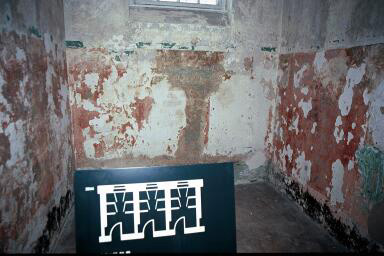 Much of the eye witness testimony of the Dachau inmates was disputed by Dachau Commandant Martin Gottfried Weiss and 39 staff members who were put on trial by an American Military Tribunal at Dachau in 1945, but visitors are not made aware of this. For example, there is a display in the bunker that shows the size of the "standing cells." The standing cells had walls that were made of wood, and they were torn down by the American liberators in 1945, according to the staff at the Dachau Museum. Both Johann Kick and Martin Gottfried Weiss testified that they had heard about the standing cells for the first time at their trial, and unfortunately there was no proof that the standing cells had ever existed because the evidence had been destroyed by the Americans before the trial. The following quote is from a blogger who described what she was told, regarding the standing cells, by a tour guide named Kevin on her recent trip to Dachau: The prison within the prison was the area where far worse could happen to you. One example: they'd keep prisoners in a room that contained no light. That prisoner would be given food once every four days and they remained in the dark for years. Then the Germans would take you out and force you to look into the sun-force you to use your eyes again and put you through excruciating pain. This was were I heard an incredible story though. A man was tortured (no idea how long), once they were done they gave him a rope and a knife and left him in his room basically saying: you have the choice to kill yourself tonight and be gone or we'll continue till you're dead. This man used the knife and the rope, not to kill himself, but to escape. He used the knife to open his cell door, and he used the rope and his bed to get over the fence. When the Germans went into his room the next morning he was out of the country. A news article by Lauren Gilcrest quotes a speech made by a tour guide named Antje Roser-Huckle: "These people [the SS] were trained
to consider these prisoners not as human beings. There was no
thinking 'I'm beating a man, or I'm beating a woman, or I'm executing
someone.'" Apparently none of the tour guides explain that the standing cells were torn down by the American liberators and the evidence of the crimes described by Ms. Roser-Huckle was destroyed. Refugee Camp at DachauEntrance to Memorial SiteArbeit Macht Frei GateInternational Monument & Unknown PrisonerDachau MemorialsGas ChamberDisinfection Chambers & ovensBack to Dachau Concentration CampBack to Table of ContentsHomeThis page was last updated on October 24, 2009 |